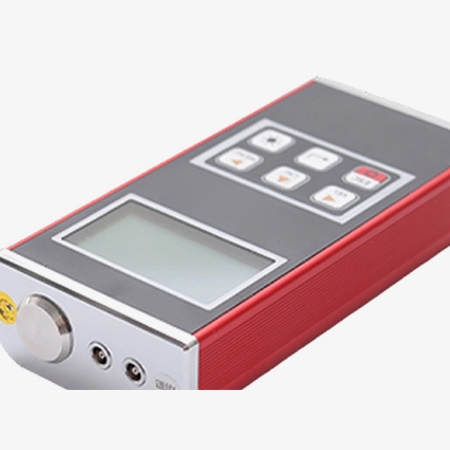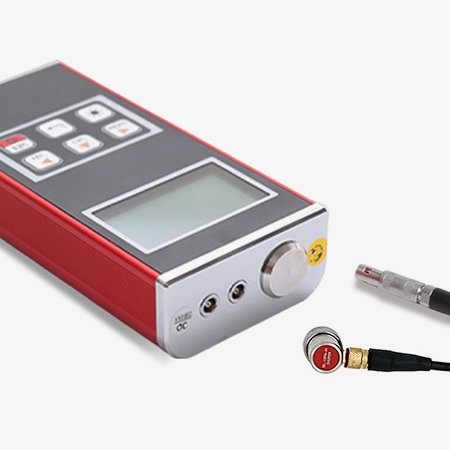This ultrasonic thickness meter is suitable for testing ultrasonic conductors such as metal, plastic, ceramic, and glass. Its high-brightness LED-backlit LCD display with automatic brightness adjustment eliminates lighting constraints and improves work efficiency even in low-light environments.

High Accuracy and Reliability
- This digital coating thickness meter features two operating modes: standard (0.65-500mm) and through-coating (0.65-50mm). It accurately measures the thickness of bare materials and can also penetrate coatings less than 3mm without damaging them, directly measuring the thickness of the substrate.
- This ultrasonic thickness meter offers a high resolution of 0.1mm and adheres to high-precision standards, ensuring accurate and reliable readings throughout the entire measurement range. It also features a coupling status indicator to ensure the validity of every measurement.
- A wide sound velocity range enables it to measure the thickness of a variety of materials that are good ultrasonic conductors, including metals (steel, aluminum, copper, etc.), plastics, ceramics, and glass. It can also measure sound velocity from a known thickness to enhance measurement accuracy for specialized materials.

Portable and Professional Applications
- The UTG thickness gauge features an aluminum-magnesium alloy housing that is resistant to shock, vibration, and electromagnetic interference, making it designed for harsh industrial environments. Its built-in lithium battery provides over 160 hours of battery life (with the backlight off), and it features automatic sleep and power-off functions, making it suitable for extended field or workshop operations.
- The UT thickness meter integrates practical features such as sound velocity detection, backlit display, and unit switching (metric/imperial), offering intuitive and easy operation. The backlight function ensures normal use in dimly lit environments, enhancing the user experience.
- The ultrasonic thickness measurement gauge is compact and lightweight, making it easy to carry. Its professional performance is particularly suitable for in-service equipment inspection, corrosion monitoring, and quality control in industries such as petrochemicals, pressure vessels, and shipbuilding.
Applications
Key application fields of SISCO pen-type electromagnetic ultrasonic thickness gauge include shipbuilding, aerospace, and automotive industries. The compact, pen-style design makes it convenient for on-site inspections and maintenance, particularly in confined spaces or at height. Additionally, the gauge is useful in quality control during manufacturing processes, helping ensure material integrity and compliance with safety standards.

Shipbuilding Industry

Automobile Manufacturing

Metal Processing

Aviation Industry
| Model | SISCO-UT-XT930 |
| Measurement Range | 0.65~500mm (standard mode, steel) |
| 0.65-50mm (through mode, steel) | |
| Penetration Range | can penetrate the coating below 3mm |
| Sound Velocity Range | 500~18000m/s |
| Resolution | 0.1mm |
| Accuracy of Indication | ±(0.6%H+0.1)mm; H is the actual thickness of the measured object |
| Working Mode | standard and through two thickness measurement modes |
| Unit System | metric or imperial (optional) |
| Working Power | lithium battery |
| Continuous Working Time | more than 160 hours (without backlight) |
| Shape and Size | 145mm×70mm×32mm |
| Weight | 340g |
Q1: What is pen-type electromagnetic ultrasonic thickness gauge?
A1: A pen-type electromagnetic ultrasonic thickness gauge is a compact, handheld device designed for non-contact measurement of material thickness. Its pen-like design allows for easy access to tight or hard-to-reach areas. This gauge is ideal for measuring corrosion, erosion, and wear in pipelines, tanks, and structural components.
Q2: How to maintain pen-type electromagnetic ultrasonic thickness gauge?
A2: To maintain a pen-type electromagnetic ultrasonic thickness meter, regularly clean the probe and device housing with a soft, dry cloth to prevent dust and debris buildup. Avoid exposing the gauge to excessive moisture, heat, or corrosive environments. Check battery levels and recharge as needed to ensure accurate operation. Periodically inspect the probe cable for signs of wear or damage. Store the device in a protective case when not in use to prevent accidental damage.
Q3: What materials can be measured using this electromagnetic ultrasonic thickness gauge?
A3: An electromagnetic ultrasonic thickness tester is ideal for measuring the thickness of conductive materials. It can accurately measure metals such as steel, aluminum, copper, and titanium, as well as their alloys.
Tips: Common Mistakes in Using Ultrasonic Thickness Gauges
Common mistakes in using ultrasonic thickness gauges include: Failure to clean the surface (e.g., residual coatings or rust) or uneven application of coupling agent (e.g., using unsuitable media such as butter or water), resulting in poor contact between the probe and the workpiece and sound wave attenuation; failure to set the correct sound velocity for the material (e.g., measuring aluminum using the sound velocity of steel), resulting in thickness calculation errors; failure to enable temperature compensation in high-temperature environments, resulting in errors due to temperature-dependent sound velocity changes; and ignoring internal material defects (e.g., interlayers or oxide layers) or improper probe selection (e.g., using a high-frequency probe to measure the thickness of a material), leading to misinterpretation of echoes or signal loss.
Thank you for buying industrial test and measurement equipment on SISCO.com, all products sold by SISCO and the partner cover a 12 months warranty, effective from the date of receiving the products.
What is covered?
SISCO is responsible for providing free spare parts, and free technical support to assist the customer to repair the defective products until the problem is solved.
What is not covered?
- Product purchased from anyone other than a SISCO store or a SISCO authorized reseller.
- Expendable parts.
- Routine cleaning or normal cosmetic and mechanical wear.
- Damage from misuse, abuse or neglect.
- Damage from use of parts other than SISCO approved.
- Damage from use outside the product’s usage or storage parameters.
- Damage from use of parts not sold by SISCO.
- Damage from modification or incorporation into other products.
- Damage from repair or replacement of warranted parts by a service provider other than a SISCO authorized service provider.
- Damage caused by the application environment not meeting the product usage requirements and the failure to perform preventive maintenance.

